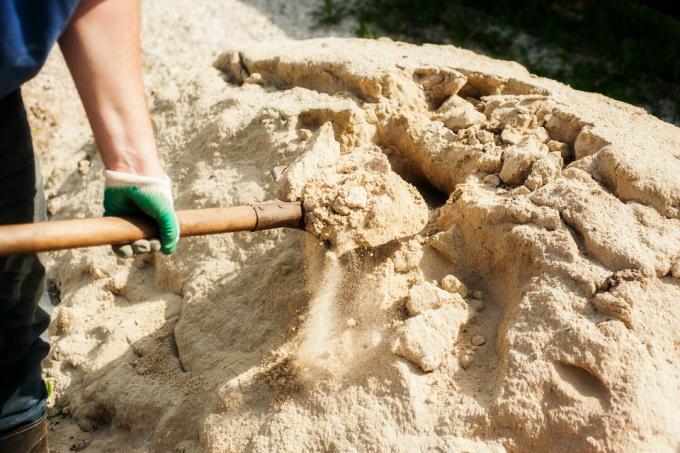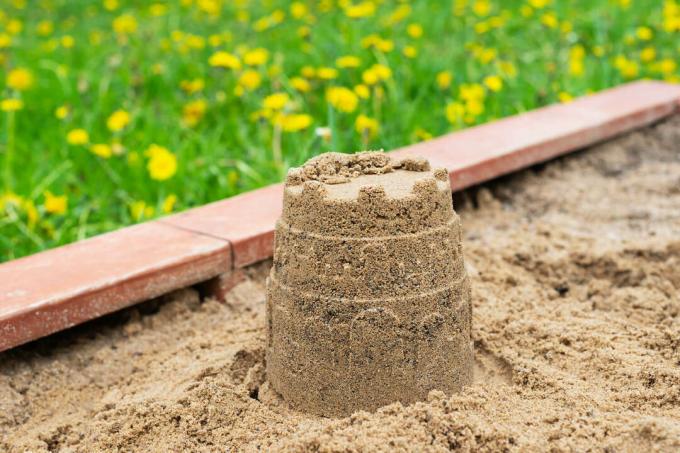Many questions arise when it comes to sanding a lawn. We clarify the most important ones and have further tips ready so that nothing goes wrong when sanding.
After scarifying and aerating comes the sanding of the lawn. At the scarify lawn thatch is removed, and the grasses are stimulated to grow denser by slight injuries to the roots. In addition, unwanted moss is briefly removed by scarifying and the soil is open and ready for fertilization and other care measures. At the lawn aeration Various devices are used, all of which aim to work the soil more deeply. This is how you improve its air and water flow. Sanding can be used independently of scarifying and aerating, but it can also be used sensibly after these maintenance measures. It is a very important method to improve the growth conditions of the lawn, especially in compacted, clayey soil under lawns.
contents
- Why do you sand the lawn?
- When is the lawn sanded?
- Which sand is suitable for lawns?
- Lawn sanding: The right amount per square meter
- Step-by-step instructions
- Sand, overseed and fertilize the lawn
- Level out unevenness in the lawn with sand
- Proper care after lawn sanding
Why do you sand the lawn?
The sanding of the lawn has various beneficial effects, which also depend on the pre-treatment – i.e. the Scarifying or aerating - as well as the existing soil, the sand used and the used depend amount. Even the device used for distribution influences the effect.
The goals of sanding are:
- Improved air flow to promote root growth of the grass
- Improving drainage and water drainage from the lawn and preventing waterlogging
- Increase in resilience, especially when walking and driving on
- Increased shear strength of the soil, especially in lawns used for sports
- Improving the wettability of the subsoil and quick drying of the lawn, which prevents the appearance of moss
- If evenly distributed with a trawl or lawn brush, sanding the lawn can also level out bumps

Basically, more sand is used when the soil in the course of a single action is long-term needs to be changed and improved because of specific problems that make lawn growth strong affect. But regular sanding with small amounts also supports the growth of the lawn in the long term and significantly increases its resilience.
Tip: Naturally very sandy soils are not additionally sanded. Because of the large gaps in the soil structure, there are no problems with waterlogging or critical compaction.
When is the lawn sanded?
Sand as a chemically inert, i.e. non-reactive, material can actually always be used. However, because the application is best done on a lawn that has been mowed at the very least - better in conjunction with scarifying or aerating - the usual time of year is spring. The lawn can also be limed or fertilized at the same time - however, lime and fertilizer should not be applied at the same time, otherwise undesirable chemical reactions can occur.

Should you aerate or scarify the lawn before sanding? Small amounts of sand can also be distributed without prior scarifying or aerating. If an aeration device with hollow cone tools, so-called hollow spoons, has worked out a lot of soil material, there is more sand per square meter. The previous processing of the surface is therefore not absolutely necessary, but makes it possible to bring in larger quantities and thus a greater effect.
Which sand is suitable for lawns?
Various grain sizes and qualities of sand can be used to sand the lawn. Dried sand is pourable, while washed sand is cleaned of very fine or particularly coarse particles. It is best to use sharply washed, pure quartz sand with a grain size of 0.06 to 2 mm for your home garden.

Can you use play sand for the lawn?
Play sand usually has a grain size of 0 to 2 mm or 1 to 2 mm. It usually contains a small amount of clay so that it holds together when baking sand cakes. This is not only superfluous when sanding the lawn, it is also a nuisance because it causes poor flowability. It is therefore better not to use play sand to sand the lawn.
Lawn sanding: The right amount per square meter
How much sand you need to sand your lawn depends on what you plan to do:
If the sand is only brushed in to level out unevenness and this process is repeated annually, as is usual on sports fields, then 0.5 to 1 liter of sand per square meter is sufficient.
After scarifying, on the other hand, 2 to 3 liters of sand per square meter are distributed.
After aerating with slot knives, 3 to 5 liters of sand per square meter are spread,
aerators with hollow cone tools should be followed by sanding at 4 to 6 liters per square meter.
The actual amount on each scale also depends on your soil type. Sanding is generally not necessary on soils that are already very sandy. The more compacted or clayey a soil becomes, the more sand you should use to improve the situation. If you're not quite sure about the topic soil types sit, you can read everything you need to know in our practical article.

Step-by-step instructions
The sanding itself is not rocket science:
- With a suitable spreader or simply with a wheelbarrow, the amount previously calculated for the area is distributed in small heaps on the lawn.
- Now the heaps can be spread with the back of the rake and then with the tines.
- The fine distribution is then completed with a coarse street broom.
If unevenness in the lawn is to be evened out, a dragnet is needed, which is pulled over the area several times - this can also be done manually with small nets. Although there are special lawn brushes that distribute the sand evenly, these are unfortunately only suitable for larger towing devices and cannot be used in private areas.
Important: If the sand is evenly distributed, the tips of the stalks should stick out of the sand everywhere.

Should you sand turf? Rolled turf differs in no way from seeded lawns after it has grown in and at the latest after a year's standing time. You can also sand turf. However, the first processing of this magnitude should only take place one year after laying. Of course it may be that before Laying the turf Sand has to be distributed to make the turf base layer more stable, shear-resistant and looser.
Sand, overseed and fertilize the lawn
Fertilizer and sand can be applied together as the sand does not react with the fertilizer in any way. For example, use a primarily organic lawn fertilizer like ours Plantura organic lawn fertilizerto improve growth in the year after treatment. The fertilizer based on recycled leftovers from the food and luxury food industry is nitrogen-rich to support rapid regeneration. Because nitrogen as the "engine of vegetative growth" is essential for the development of fresh stalks. 70 to 100 g organic lawn fertilizer per square meter can be distributed before sanding.

Immediately after aerating and scarifying, overseeding may take place. However, the two measures also stimulate the branching of the existing grasses, so it will grow denser after scarifying anyway. Planting more seeds increases the risk of a fungal disease on the lawn.
Therefore, only resow if the undergrowth was already clearly decimated before scarifying - i.e. if you could see a lot of soil between the stalks. If the lawn appears flat, the overseeding with a Lolium perenne- Mixture the right choice. The vigorous and regenerative grass ensures a dense look. If, on the other hand, the lawn is completely missing in some places, it is better to use a mixture for Lawn Repair. This contains both fast-germinating and competitive grasses and occupies the gap until the hole has grown back from the sides.
Level out unevenness in the lawn with sand
Sand can also be used to even out small bumps. However, the useful usability is limited: deep cavities should not be filled with pure sand, but with a mixture of garden soil and some sand. If the lawn is just a little uneven everywhere, the sand is spread evenly over a large area with a trawl net - on these In this way, a much more even surface is created than if an attempt is made to use a broom to clean a flat surface model.

Proper care after lawn sanding
Immediately after scarifying or aerating, the lawn is best not walked on until the next lawn cut after about a week, but it is thoroughly watered. If the lawn has only been sanded with a little sand and without prior tillage, it can be used normally again immediately after extensive watering. Plenty of water from above ensures that the sand is washed in a little, settles in the existing soil and is soon worked into the soil structure by soil life and the roots. In addition, any fertilizer used is softened or dissolved so that nutrients are released or be mineralized by soil life - now the lawn with its improved growth can begin.

In addition to sanding, fertilizing is also an important care measure for the lawn. In our special article you will find out everything about lawn fertilizing, what you need to know.


